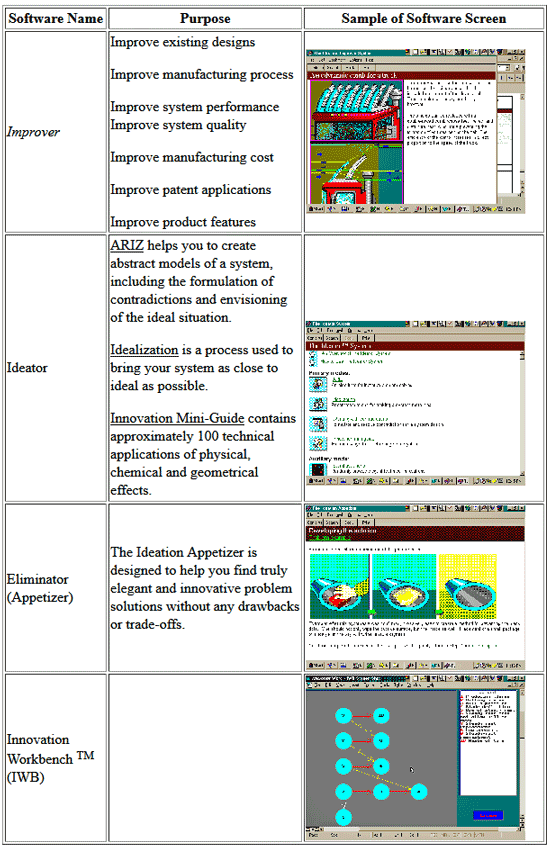Shared here are some of Glenn Mazur’s lecture series that he taught at various Engineering and Business schools. We value the spread of useful ideas. Please insert the copyright notice as shown in the box below, before using any part of Mazur’s TRIZ materials.
4.0 Additional TRIZ Tools
The TRIZ methodology can be adapted to different kinds of problem solving. The method described above is relatively simple but forces the user to pre-formulate the problem in terms of standard engineering parameters. It rarely leads to an exhaustive set of solutions. Thus, it is used primarily to solve level two type problems as explained in Table 1. More difficult problems are solved with the following more precise tools.
4.1 ARIZ (Algorithm for Inventive Problem Solving)
A systematic procedure for identifying solutions without apparent contradictions. Depending on the nature of the problem, anywhere from five to sixty steps may be involved. From an unclear technical problem, the underlying technical problem can be revealed. Can be used with levels two, three, and four problems. Basic steps include:
Formulate the problem.
Transform the problem into a model.
Analyze the model.
Resolve physical contradictions.
Formulate ideal solution.
4.2 Su-Field Analysis
A tool for expressing function statements in terms of one object acting on another object. The objects are called substances and the action a field. Su-field analysis is helpful in identifying functional failures. By looking at actions as fields, undesirable or insufficient actions can be countered by applying opposing or an intensified fields.
4.3 Anticipatory Failure Determination (AFD)
Prevention of unanticipated failures is important in new product development. AFD, in effect, invents failure mechanisms and then examines the possibilities of their actually occurring. Factors contributing to the failures can be eliminated with this highly pro-active technique.
4.4 Directed Product Evolution (DPE)
Traditional technological forecasting tries to predict the "future characteristics of … machines, procedures, or techniques." It relies on surveys, simulations, and trends to create a probabilistic model of future developments. It gives a forecast, but does not invent the technology being forecast.
Altshuller, by studying hundreds of thousands of patents, was able to determine eight patterns of how technological systems develop over time. Based upon the patterns of how people think rather than what people think, DPE is like a road map into the future. Rather than predicting future technologies, one can systematically invent future technologies using DPE. The eight patterns of Directed Product Evolution are given in Table 5. Examples will also be shown.
Table 5. Patterns of Evolution of Technological Systems.
By analyzing the current technology level and contradictions in our products, TRIZ can be used to see the evolutionary progress and create the future. For example, Altshuller was able to predict the future technology of glass plate manufacturing. The earlier process was to roll hot glass onto a conveyor. During this process, the glass would tend sag between the rollers resulting in waviness in the final product. Using pattern #7, Transition from Macro to Micro, Altshuller predicted that rollers would get smaller and smaller until they reached the theoretical limit of atom sized. Several years later, an English company introduced a new process of rolling the glass out on a bath of liquid tin. Directed Product Evolution can be used to develop patents for future technology before one's competitors.
TRIZ with QFD
Since TRIZ can help engineers and developers solve technical contradictions and invent new technologies, it's use in New Product Development is very important. Combined with Quality Function Deployment (QFD), a company should be able to identify important customer requirements and then solve any technical bottlenecks that arise. TRIZ can also help identify new functions and performance levels to achieve truly exciting levels of quality. The following Table 6. shows areas where QFD and TRIZ can compliment each other.
Table 6. Using QFD and TRIZ Together.
6.0 U.S. Companies Using TRIZ
Here is a list of some of the companies that have begun studying and using TRIZ in the U.S. since 1993.
Allied Signal Aerospace Sector
Chrysler Corp.
Emerson Electric
Ford Motor Co.
General Motors Corp.
Johnson & Johnson
Rockwell International
UNISYS
Xerox Corporation
more...
TRIZ Software
Because TRIZ is built on a database of hundreds of thousands of patents, principles, operators, contradictions, etc. use of software helps engineers with minimal training achieve timely results. For example, here is a description of some of the early software packages available from Ideation International Inc.
8.0 References
The information on TRIZ pages at www.mazur.net has been provided by and used with the permission of Ideation International Inc. These pages were created by Glenn Mazur. For questions, please contact me.




